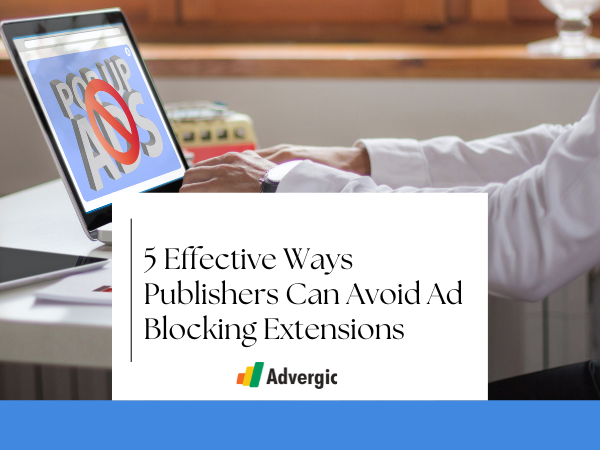Without a question, ad blocking extensions cost publishers a lot of money. Publishers who make money through …
Without a question, ad blocking extensions cost publishers a lot of money. Publishers who make money through ads need to take steps to make sure they get paid. Here are five things you can do to keep getting money from ads.
Publishers are now worried about ad blocking more than ever. They lost around $12.12 billion in ad income in 2020 because of people who block ads. So, online ad publishers are looking for ways to increase their earnings, improve their average revenue per visitor (ARV), and build stronger, longer-lasting relationships with their loyal customers. One way they can do this is by focusing on AdBlock recovery options.
Also, knowing how ad blockers work could change every part of a publisher’s revenue plan, from the ad server they choose to the ad formats they like. Let’s jump right in!
How Ad Blocking Extensions Work?
An ad blocker is an extension or an add on for your computer that either hides ads or shows something else instead of them. This is the reason why 25% of ads don’t connect with their intended audience and are a waste of money. List filtering and ad blocking are two of the most popular parts of software that blocks ads.
Advertisement blocking tools are either built-in (like Chrome’s Better Ads Guidelines) or browser add-ons (like Adblock, Adblock Plus, etc.) to stop annoying ads, turn off trackers, and protect against malware.
The ad blocker looks at the page’s code to find websites and files that it is supposed to block by default, as well as parts that the user has told their browser not to load. Using these kinds of criteria and limits, an ad blocker stops the ads from showing up. You can stop ads in this way:
- Blocking Ads: An ad blocker’s main job is to stop flashy ad formats like pop-ups, autoplay video ads, pop-unders, and flash banners from showing up.
- Element Blocking: Extensions that block ads can also stop certain parts of a website from showing up, like big media files, third-party fonts, or scripts.
- Getting rid of social sharing buttons: Blog posts and stories often have social sharing buttons added to them. Some ad blockers, additionally, can stop the social sites from connecting.
- Disabling Tracking: This feature of an ad blocker lets you stop activity tracking, which makes surfing the web more private.
- Domain Blocking: Software that blocks ads also keeps “blocklists” of domains and websites that might have bugs on them.
- Serving Ads: Many of the best ad blockers make extra money by showing their users smaller versions of ads. In exchange, the ad blocking business gets a cut of the authors’ ad revenue.
Publishers who have trouble with ad blocking need a way to make money from ads on their content. But there are some things they can do to deal with ad blockers and get back the money they lost.
Strategy #1: Use server-side ad insertion
SSAI, or server-side ad insertion, is a technology that sends ads along with video material and combines them into a single stream on the CMS level instead of in the browser.
In the case of OTT services, users see different ads even if they’re watching the same show on the same day. So, an ad server puts the ad inside the video and uses the CDN to send it to the player.
Ad blockers can’t tell the difference between video content and breaks, even if there are ads stitched into the video stream. That’s how it gets around software that blocks ads. Simply put, SSAI gets rid of the process of asking for ads and lets playing happen without any problems.
Publishers and marketers are becoming more interested in SSAI as they lose money because of ad blocking, even though it has been around for a long time. By putting videos and ads together, it improves the user experience overall and lets both sides avoid ad blockers. SSAI also makes sure that material is sent in a single stream so that people can watch ads more easily.
Strategy #2: Acceptable Ads Save the Publisher
Users want ads that are easy to understand, and advertisers can make money by showing such ads without hurting publishers’ ad income.
Eyeo started the Acceptable Ads program. Eyeo is the company that made AdBlock Plus. The rules that these ads follow were made for and by people who stop ads. A study says that in 2021, the accepted ads opt-in rate went over 95%. In addition, 216 million people who stop ads chose to support this project in 2021 and 2022.
Eyeo has established the latest standards, incorporating four ad formats into the list of acceptable ads.
- In-content between paragraph, static – 728×90
- In-content between paragraph, static – 840×150
- In-content ad – 300×250, end of images (page 4 of 4), static
- In-content ad – 468×400, end of images (page 4 of 4), static
Eyeo has also set up a list of ads that only show on mobile devices. Here are the rules for where and how big mobile ads can be:
- Mobile ads that don’t move can be put anywhere on the mobile page by publishers.
- They can also stick little ads to the bottom of the screen. You can’t use any other type.
- Under the main text, you can put large native ad types.
- Ads shouldn’t take up more than half of the page’s width.
- The highest point that sticky ads can be is 75px.
- The mobile ad that appears below the main content can take up the whole screen.
Publishers may be able to make up some of the money they lose to ad blocking extensions with Acceptable Ads, all without having to make any changes to their site.
Strategy #3: Native Advertising
Many publishers and marketers are shifting from display ads to native ads due to ad blockers, which reduce the visibility of regular banners. Spending on native ads rose from $47.33 billion in 2020 to $57.27 billion in 2021, and projections indicate it will reach $400 billion by 2025.
As little as possible, native ads should not get in the way of the user’s experience. Native ads, on the other hand, look and work like content on your website or app. You don’t have to call them “advertisements.” You can call them “Sponsored” or “Promoted” material instead.
Ads on social media sites or branded, promoted, or paid content on a website are two examples. Additionally, server-side integration allows native ads to function without requiring the addition of ad tags to the web page. It gives users a smooth experience, makes ads look better, speeds up page loads, and protects against malware threats.
In addition, this kind of ad unit helps fight browsers that stop ads. So, producers can use native ads to get people to trust and know their brands. Switch to native advertising if you tire of ads that get in the way, as it only adds interesting and useful content to the page.
Strategy #4: Make use of programmatic audio
Programmatic methods can help publishers get around ad blockers. Using ad blockers makes it harder for ads to reach their intended viewers, which mostly affects publishers’ inventory, which is what makes them money.
Automatic audio ads frequently play during podcasts. Ad blocking extensions hide ads, causing audio programmatic audio ads to potentially go unnoticed. Therefore, programmatic music is one of the best ways to deal with ad blockers. Therefore, you should think about putting audio spots on your website and then selling audio content through a supply-side platform.
As a similar example, programmatic solutions let you buy and sell digital ads automatically and show a specific ad to a single customer in a single context and in real time. Users that publishers and advertisers can target will be more likely to respond to their ads, which will improve their return on investment (ROI). So it’s clear that publishers need to join the programmatic shift to make ad blockers less necessary.
Strategy #5: Pick the right ad tech company
You can get back the ad revenue you lost because of ad blocking extensions by working with an ad tech platform like Advergic that makes ads very easy to see. Make sure that they give publishers the best ad reinsertion technology so that users have a good experience.
A lot of the time, ad servers that care about their customers offer ad forms that make the user experience better and help them find what they’re looking for instead of annoying them. People who normally use ad blockers will probably clear the publisher’s website if this happens.
An ad tech partner should also spend money on SEO, the right keywords, ad content, social media, and other ways to get people to see your ads. They can then help build your business in every way.
Have questions about Header bidding wrapper and price granularity?
Schedule a free consultation with our Header Bidding Expert today 📞

